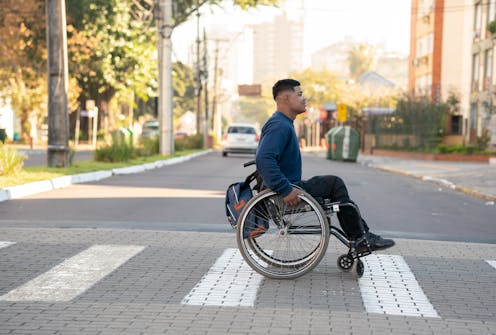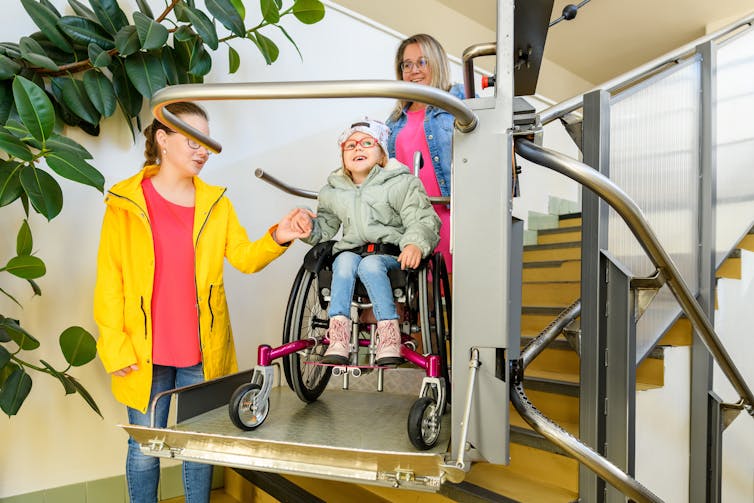Date:
Author: Rss error reading .
Original article: https://theconversation.com/from-barriers-to-belonging-how-supporting-inclusivity-enhances-the-well-being-of-people-with-disabilities-249339

What does it mean for a city to be accommodating to all its citizens?
This requires understanding how individuals feel included and valued in the places they live, and responding to their needs by emphasizing genuine inclusivity. For people with mobility challenges, it means feeling no different from others. This applies both to navigating urban spaces and engaging in social interactions.
Despite efforts to improve accessibility in Canada, many urban spaces still fall short, leaving wheelchair users facing subtle but persistent barriers. We wanted to understand the different challenges and barriers people with disabilities face when using mobility aids.
To do this, we interviewed 12 experienced physiotherapists in Iran to identify gaps in how mobility aid serve the needs of those who use them, and offer recommendations based on their extensive interactions with users.
Given the universal needs of mobility aid users — emotional well-being, social integration and functional independence — and the common challenges they face accessing health-care systems around the world, our findings can are relevant for many people around the world, including in Canada.
Inclusive design
To create truly inclusive cities, it is vital for policymakers and experts to go beyond minimum standards and critically examine how our urban spaces continue to exclude people with disabilities.
Marketing professors Vanessa Patrick and Candice Hollenbeck have developed the DARE framework — design, appraisal, response and experience — and propose three levels of inclusive design aimed to make spaces more inclusive for people with disabilities.
Level 1 ensures accessibility through industry regulations, meeting minimum standards. Level 2 fosters engagement and equity, rooted in social justice principles, by validating user experiences and emphasizing empathy. Level 3 aims to minimize mismatches between users and design, promoting human flourishing through seamless interaction among individuals, the design and their environment.
Our study outlines how people perceive the inclusivity of mobility aids based on the cost, how they are built and how effective they are in different environments.
We also considered perceptions of trustworthiness, support and contextual factors, including the social interpretations and representations of these devices. We highlight gaps in users’ needs and provide recommendations to address them. Through this analysis, we identified four key themes that offer valuable insights for enhancing inclusivity.
Financial burden
For some, mobility aids can be an added financial burden. Financial constraints may limit access to mobility aids, often forcing users to seek alternatives or delay rehabilitation, potentially worsening their conditions. For example, individuals might resort to second-hand mobility aids which may not be fitted correctly for them.
Globally, only five to 35 per cent of the 80 million people who need a wheelchair have access to one depending on where they live, with high costs being a primary barrier.
The high cost of advanced electric wheelchairs further restrict access. This marks a gap at the first level of inclusivity in the DARE framework, where market-driven prices fall short of meeting mobility aid users’ needs.
Initiatives like the European Union’s Rehabilitation Policy Action Framework have called for increased governmental financial support for mobility aid users. This framework offers 48 options across six domains to translate political goals into action, such as reallocating health-care funds to expand rehabilitation and improve inclusivity.

(Shutterstock)
Mismatches between users and mobility aids
In using mobility aids, a user will typically evaluate two aspects: the design features of the aids themselves and how well they function in their environment.
If the mobility aid is slightly mismatched with their requirements, the user may find alternative solutions, such as adding padding to a wheelchair to relieve pressure. However, severe mismatches can lead to negative outcomes and result in unmet mobility needs. Furthermore, inadequate anthropometric and ergonomic adjustments can lead to discomfort.
Similarly, environmental mismatches, such as barriers that disrupt navigation, can reinforce negative stereotypes and condescending attitudes. These barriers can hinder a person’s mobility and ultimately deter them from going out and engaging in social activities.
New developments and technologies can not only address and mitigate certain mismatches but also positively impact users’ psychological and social needs. However, integrating new technologies requires careful consideration, as assistive devices can also attract social stigma.
Therefore, it is important to identify which technological or esthetic features of mobility aids evoke positive emotions and minimize stigma.
Mobility aid users, like everyone, deserve equal consideration in design and planning. Programs like Europe’s Design for All (DfA) and Singapore’s Barrier-Free Accessibility (BFA) promote barrier-free design for all abilities and socioeconomic backgrounds.
Improving trust
Trustworthiness is a critical factor in the use of mobility aids, particularly in unfamiliar settings where users may feel uncertain.
To address this, users seek continuous reassurance about the reliability of their aids, often depending on the support of physiotherapists to navigate mismatches between their needs and their surroundings. Such professional support enhances confidence and mental well-being. Physiotherapists, as trusted experts, can remarkably shape users’ perceptions and acceptance of mobility aids.
Ensuring trustworthy designs is also crucial, as perceived fragility can undermine user trust. Validating experiences, building trust across environments — including trust in physiotherapists and mobility aid products — is essential to alleviating doubts about how effective they might be.
Sociocultural influences
Sociocultural context and the causes of a disability play a significant role in shaping perceptions of mobility aids.
Regardless of users’ personal experiences, others tend to view mobility aids through the lens of prevailing societal attitudes toward disability. For some, mobility aids may reinforce stereotypes about disabilities. This highlights the critical role of esthetics in shaping public perceptions and social interactions.
For example, incorporating esthetic refinements into the design can help counter negative perceptions. By addressing negative representations and promoting designs that reflect dignity and inclusivity, interventions can align with inclusively goals and enhance positive social engagement.
Raising public awareness is key to challenging stereotypes and building empathy. To create an inclusive society, design and planning should consider both the physical and social barriers to accessibility. Achieving this requires a multi-disciplinary effort, and the active participation of people who use mobility aids.
This article was co-authored by Morteza Farhoudi, an inclusive designer specializing in public transportation studies.
![]()
Mohsen Rasoulivalajoozi receives funding from Social Sciences and Humanities Research Council of Canada.
Carmela Cucuzzella receives funding from Social Sciences and Humanities Research Council of Canada.
